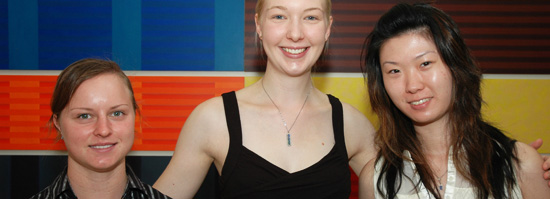Intervet-Schering Plough Animal Health.

Amanda Vardanega, National Swine Manager with Intervet-Schering Plough hosted the “Manipulating Reproduction in Pigs” Reproduction Seminar in WA and is pictured with Murdoch University Veterinary Science final year students and Hilduard Swarts, Global Marketing Director of the Global Swine Business Unit for Intervet-Schering Plough and Dr Yvette Miller of Portec Australia.
Netherlands-based and an internationally recognised specialist in the application of breeding technologies on pigs farms, Mr Swarts addressed about 200 producers and industry stakeholders in all mainland Australian states last week on manipulating reproduction in pigs.
“For example, if a producer manages to improve sow output from 21 to 22 piglets a year, profits may double, despite a change in piglets numbers of only about five per cent,” he said.
His presentations covered batch farrowing, manipulating heat cycles, fixed time insemination and the importance of production parameters on financial impact.

At the Intervet-Schering Plough “Manipulating Reproduction in Pigs” Reproduction Seminar in WA were pork producer Steve Lyneham of Popanyinning and Hilduard Swarts, Global Marketing Director of the Global Swine Business Unit for Intervet-Schering Plough.
Mr Swarts told producers that a good start to improving sow productivity and therefore piggery profitability was to induce heat on schedule by using specific hormonal treatments to initiate cycling.
“Synchronising heats gives you the best use of housing and easier batch farrowing of piglets by age, allowing you to move them all to the one place at the one time,” he said.
Mr Swarts said that batch farrowing was very popular in Europe, especially in France, where producers enjoyed its many management benefits, including a change in mindset to “I don’t have individual sows, but, rather, I have 20 batches.”
Synchronising heat in cycling gilts and sows, by using the Intervet-SP oral progesterone-like product to inhibit the hormones that promote development of egg folicles within the ovaries, was simply a matter of feeding the medication for 18 consecutive days and then stopping. This removed the inhibitory effects of progesterone, allowing normal oestrus cycling to return.
“Ovulation induction then allows you to better manage artificial insemination, including using less semen and you can generally manage your staff and piggery breeding unit more efficiently and more profitably,” Mr Swarts said.
“Staff rostering improves and the need for highly skilled and expensive labour lessens.”
Another advantage of ovulation induction, using Intervet-SP technology, was that oestrus detection was no longer necessary, but simply needed to be confirmed.
“The oral progestagen treatment is a very flexible tool for planning the onset of follicular development and can especially improve productivity in gilts,” he said.
Several studies in a number of countries also showed an increase of about 0.7 piglets born alive per litter, when the treatment was used.
“While this particularly applied to parity one and early weaned sows, it was also observed in gilts,” Mr Swarts said.
He explained that feeding the progestagen for nine days after weaning allowed parity one sows more time for endocrine and uterine recovery and a greater parity two litter size.
New South Wales-based Amanda Vardanega, National Swine Manager with Intervet-Schering Plough Animal Health, hosted the Victorian, NSW, Queensland, SA and WA seminars with Mr Swarts. She said the feedback from producers was that they welcomed his international perspective on how best to maximise pig reproductive performance.

At the Intervet-Schering Plough "Manipulating Reproduction in Pigs" Reproduction Seminar in WA were (L to R) Holly Brown, Jenna Evans and Rachel Tong, all Murdoch University Veterinary Science final year students.
“While Australia’s pork production sector has access to reasonable genetics, quality feed and a relatively skilled workforce, there’s always room for improvement.
“A real difference can be made to producers’ bottom lines by introducing world-leading technologies to improve productivity and that’s where Intervet-SP can help by giving producers face-to-face access with Hilduard Swarts, a recognised leader in the field,” she said.
Pork producers wanting to explore manipulating reproductive performance in their breeding herds should discuss different approaches with a veterinarian skilled in pig medicine.
www.intervet.com.au



